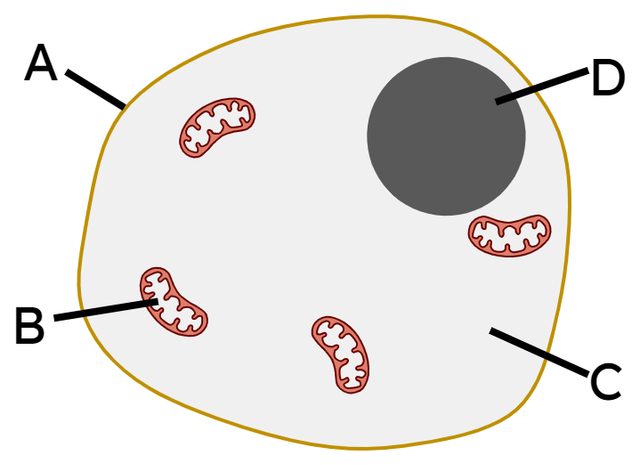Starter quiz
 What is the name of the structure labelled A in the diagram of an animal cell?
What is the name of the structure labelled A in the diagram of an animal cell?- cell membrane ✓
- cell wall
- cytoplasm
- nucleus
-
 What is the job of the cell membrane in an animal cell?
What is the job of the cell membrane in an animal cell?- It controls what can enter and leave the cell. ✓
- It is a fluid that fills the cell.
- It is where photosynthesis takes place.
- It stores the cell’s DNA.
-
 The cell membrane has lots of small ______ in it.
The cell membrane has lots of small ______ in it.- 'holes' ✓
 Who correctly explains how the particles of oxygen got into the cell?
Who correctly explains how the particles of oxygen got into the cell?- Jacob: “The cell breathed the oxygen particles in.”
- Aisha: “The particles diffused through the cell membrane.” ✓
- Lucas: “The cell sucked them in from the blood.”
- Sofia: “The cell is fully permeable to all particles, including oxygen.”
-
 Particles of carbon dioxide …
Particles of carbon dioxide …- can move through the cell membrane in both directions. ✓
- cannot move through the cell membrane.
- will only move through the membrane from inside the cell to outside the cell.
- will only move through the membrane from outside the cell to inside the cell.
-
 The ______ movement of carbon dioxide particles will be from inside to outside.
The ______ movement of carbon dioxide particles will be from inside to outside.- 'net' ✓
Exit quiz
 Particles of iodine can only move through holes in the membrane because they are ...
Particles of iodine can only move through holes in the membrane because they are ...- concentrated.
- heated.
- large.
- small. ✓
-
 Particles of starch are too ______ to move though holes in the membrane.
Particles of starch are too ______ to move though holes in the membrane.- 'large' ✓
 Particles of iodine move through the membrane into the tubing due to diffusion down a ______ gradient.
Particles of iodine move through the membrane into the tubing due to diffusion down a ______ gradient.- concentration ✓
- diffusion
- movement
- net
-
 Because particles of iodine can move through the membrane but particles of starch cannot, the membrane is described as ______-permeable.
Because particles of iodine can move through the membrane but particles of starch cannot, the membrane is described as ______-permeable.- 'selectively' ✓
 The diagram shows the experiment at the start. Who correctly predicts what the liquid inside the tubing will look like after 10 minutes?
The diagram shows the experiment at the start. Who correctly predicts what the liquid inside the tubing will look like after 10 minutes? Alex: “It will be yellow or pale brown.”
Alex: “It will be yellow or pale brown.” Andeep: “It will still be colourless.”
Andeep: “It will still be colourless.” Sofia: “It will be blue/black.” ✓
Sofia: “It will be blue/black.” ✓
 The diagram shows the experiment after 10 minutes. Match each observation to the correct explanation for it.
The diagram shows the experiment after 10 minutes. Match each observation to the correct explanation for it.- liquid inside the tubing is blue/black⇔starch and iodine are both present ✓
- liquid outside the tubing is pale brown⇔only iodine is present, no starch ✓
- full colour change took a few minutes⇔iodine diffused into the tubing from the edges to the middle ✓
Worksheet
Presentation
Video
Lesson Details
Key learning points
- Particles of some substances are small enough to diffuse through holes in a selectively-permeable membrane.
- Particles of these substances move through the selectively-permeable membrane in both directions.
- Predict the direction of net movement of particles through a selectively-permeable membrane.
- Observe the direction of net movement of a substance through a selectively-permeable membrane (e.g. Visking tubing).
- Explain observations of the diffusion of a substance through a selectively-permeable membrane.
Common misconception
Particles only move through a selectively-permeable membrane in one direction.
The lesson explores the idea that particles move through a selectively-permeable membrane in both directions, but that net movement is down a concentration gradient.
Keywords
Selectively-permeable membrane - A membrane is selectively-permeable if some substances can move through it but others cannot.
Particles - All substances are made up of particles that are too small for us to see.
Diffusion - Diffusion is the net movement of particles of a substance down a concentration gradient.
Concentration gradient - A concentration gradient is a difference in the concentration of particles from one area to another.
Net movement - Net movement is the overall movement of particles from one area to another.